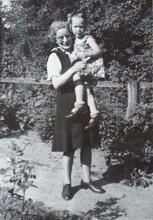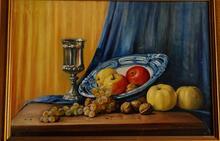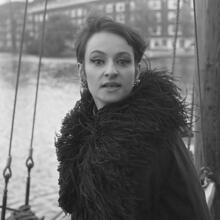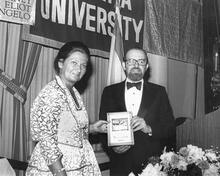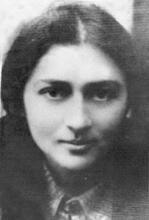Marta Friedländer-Garelik
The third Austrian woman to do so, Marta Friedländer-Garelik obtained a PhD in law in 1922 and established a legal practice in 1933. In 1938, the Nazi government prohibited Jewish lawyers from practicing. Blonde and blue-eyed, Friedländer-Garelik was able to continue practicing; she freed prisoners from Dachau by promising they would emigrate. Three months later Friedländer-Garelik escaped Vienna through Belfast, but her escape route turned out to be a scheme and she was put to work in a factory. She turned out to be very talented in handicrafts, however, and the factory had to employ an additional 80 people to meet demand for an outfit she designed. Friedländer-Garelik emigrated to the United States in 1941, where she started her own very successful knitwear factory in Texas.
Family History & Jewish Practice
Marta Friedländer, the eldest daughter of the Friedländer family, was born in Vienna on December 26, 1906. Her father came from Przemysl and had found his way to Vienna after passing his Matura (high-school examinations for university entrance). In Vienna he became the editor-in-chief of the Vienna newspaper Der Abend (The Evening). Her mother, who was born in Vienna on November 9, 1870, had received the usual brief school education of that time for girls preparing to be homemakers, but was deeply interested in medicine, a career she had always wanted to pursue. However, in her youth, a university education was still closed to women. When her father died at an early age, her mother had opened a small grocery shop to make a living. Since Marta’s mother wanted her own children to have all the opportunities she herself could not enjoy, she supported her daughter’s later dream to study.
Marta grew up in a social democratic and Jewishly influenced parental home. Her mother kept a kosher kitchen; they celebrated the Passover Lit. "order." The regimen of rituals, songs and textual readings performed in a specific order on the first two nights (in Israel, on the first night) of Passover.seder at the grandparents’ home; the family attended synagogue on Jewish high holidays and paid their dues to the Jewish community. But they never really took part in the active life of the Jewish community, even though most of the family’s friends were also Jewish.
Early Education
For the first eight required school years Marta Friedländer attended an elementary school that she later described as having been in a dark, gloomy four-story building. The foul smell of the toilets lingered all around and there was hardly any light in the classrooms. On the very first school day the class was divided into Jewish and non-Jewish pupils. The former were seated next to the corridor, while the latter were seated next to the window. But Marta was a very good pupil and quickly managed to gain the attention of her teachers. After graduating from elementary school, she did not want to go on to high school (Gymnasium), both because there were only very few institutions that accepted women and because they were very expensive. Her mother, determined to ensure that her daughter enjoy what she herself had missed, took her to a factory, where the sight of young women employed in automatic, “mindkilling” labor persuaded Marta to continue her education. Her good grades won her a scholarship to the Realgymnasium, where her own lifestyle was very different from that of her wealthier classmates: she was the only girl out of twelve whose parents could not afford the tuition fee. Ostracized by the others because she was poor, she nevertheless persevered and left school in 1918 having completed the Matura.
Although her mother tried to convince her to study medicine, Marta preferred law, for three reasons: medicine required total dedication, the family lacked money, and as a schoolgirl she had worked part-time as a typist in Dr. Fritz Kamman’s law office, where she gained her first insights into law and gained the impression that law was her true calling.
Law Education & Career
In the summer semester of 1918 Friedländer enrolled in Vienna University’s law faculty, where she was one of the first women to venture into these studies. However, her teachers and male colleagues were very protective, she later recalled. She joined the organization Friends of Nature and a social democratic organization, but the constant violent clashes between the Christian and Jewish fraternities, which mostly took place on the staircase leading to the university building and led to blood flowing down the steps, greatly disturbed her. Study in the library was also a major undertaking, since if a Jewish man spoke to Friedländer in the presence of a “protector” from another fraternity, he would be attacked. After four years of study Friedländer left Vienna University with a Ph.D. in law, swearing that she would never again set foot there.
There followed a seven-year-long, very poorly paid legal training at a court and a law office prior to taking the Bar examination. She spent the first year at court before returning to Kamman’s law office for the next five years. In addition to the legal education she received in the law office, she continued to work as a typist in order to earn supplementary income.
In 1933 Friedländer attained her license to establish a legal practice. Only two other women lawyers in Austria preceded her: Marianne Beth and Julie Riesenfelder. Beginnings were hard, since nobody wanted to employ a woman; but her successful pleading in her first cases—and the fact that she was a pretty woman—worked to her advantage, as she later reported. Many judges and officials at the court and in the ministries liked to help the young lawyer, arousing suspicion among her male colleagues that she was being given undue preferential treatment.
Impact of the Anschluss
In 1938, two weeks after the Anschluss of Austria to Germany, Marta Friedländer’s farsighted mother was certain that Jews would soon have to leave the country. Despite her own past experience of anti-Semitism, Friedländer hoped that she would be able to resume her life normally. She later recalled the night of March 11–12 as the most horrifying of all her experiences: People marched past her window and drums were beaten all night. Because her uncle worked as a reporter for a Paris newspaper, her family knew of the situation throughout Europe. At the courts on the day after the Anschluss, Friedländer was greeted with words of congratulation by a colleague; he assumed that since Jewish lawyers would now lose their jobs, there would be more clients for her. He was shocked and embarrassed when he learned that she was Jewish. The next shock came with the newspaper headline on March 12. The new chief of the Supreme Court, Dr. Schaubert, who had for years been her mentor and her “very best and devoted friend,” must have been a secret Nazi in order to receive such a prestigious position so quickly.
On March 31 the Nazi government provisionally prohibited Jewish lawyers from practicing. Only 100 of the 1,300 Jewish lawyers in Vienna were allowed to practice on behalf of other Jews. Blonde and blue-eyed, Friedländer continued practicing law with no difficulty. In those five months she earned more money than ever before. She freed prisoners from Dachau by promising the government that they would emigrate. Beginning on May 2, 1938, prisoners released from Dachau and Buchenwald had to acquire emigration papers as a preliminary condition for their release. The Nazis threatened to return them to the concentration camps if they did not leave Austria within seven days.
Immigration to Belfast
Immediately endangered was her brother, Otto Friedländer (b. Vienna 1908–d. USA 1949). After learning that the French Embassy was accepting bribes for visas, she managed to get one for her brother and that evening he was en route to France. Marta Friedländer herself did not leave Vienna until August 1938. On June 22, she was forced to close her legal practice. Searching for a possibility to guarantee their security, she and her mother perceived two possibilities: marriage or flight to Ireland. The Vienna marriage rate in 1938 was the highest ever, and Marta received several offers, but she chose the offer of a passage to Ireland from a client in London. She arrived in England penniless.
Marta Friedländer’s escape route turned out to be a scheme to make money off a group of refugees by putting them to work in a factory in Belfast—in her case nominally as a handicraft teacher but in reality also as a secretary, cook, and dish washer—and all this without pay. The refugees lived in very unsanitary conditions, always under the threat that they would be sent back. After teaching herself English by reading a romance novel many times over, she eventually went to the authorities with her case and found help. The factory in which the refugees were put to work was taken under governmental supervision. Marta Friedländer proved to be very talented in handicrafts and designed a very successful outfit. To ensure supplies for the great demand, the factory had to employ between 80 and 100 people. The success was beyond her wildest dreams.
Immigration to the United States
Marta’s mother, who had stayed behind in Vienna in order to arrange for the shipment of their furniture to Belfast, arrived there herself in 1939 and died there in 1941. Her husband, who had been sick for some time, remained in a Jewish hospital in Vienna, where he died in 1940. Friedländer later managed to bring her brother from France. Since Otto Friedländer was sickly and, as a man, could not get a work permit, the siblings decided to leave for the United States on an affidavit that Marta received from one of her American clients. They arrived in New York on May 5, 1941. Learning that they would find it hard to make a living there, they moved to Texas, where Friedländer started her own knitwear factory with a business partner. The sweaters she produced were soon well known all over the country and the company proved so successful that she never returned to her profession as a lawyer.
In 1944 Friedländer married a Jewish farmer of Russian origin named Garelik. After her husband’s early death she moved to Charlotte, Virginia, close to some of his relatives. Here she spent the many last years of her life, in a circle of close friends, still alert and deeply interested in cultural activities.
She died in Charlotte in 1996, mourned by many friends and by the Jewish community.
Fishman, Aleisa. Austrian Anti-Semitism: One Woman’s Experience. March 29, 1990. Seminar by Dr. Claudia Koonz. Leo Baeck Institute, New York: 1990.
Ingrisch, Doris. “Vertriebene und Verbliebene. Zur Geschichte intellektueller Frauen in Österreich.” In Zeitgeschichte 1–2/24. Jahrgang/24 (1997), H. 1–2, S. 30–48 (45).
Primary Sources
Oral History Interview, Special Collection, UNC Charlotte.
Material by Aleisa Fishman based on Martha Garelik’s private documents.
Freidenreich, Harriet Pass. Martha Garelik Questionnaire. In Verzeichnis der Rechtsanwälte in Wien, Niederösterreich und im Burgenlande ab 1933 bis 1938. Vienna: 1933–1938.

